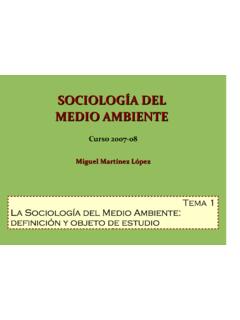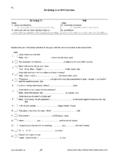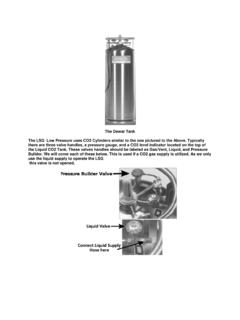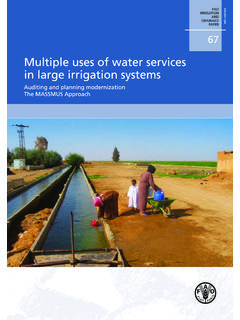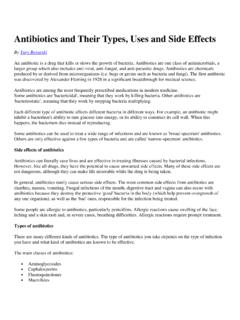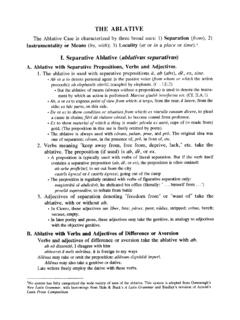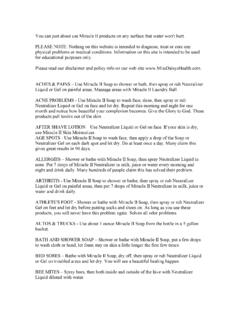Transcription of The Uses of Sidewalks: Safety - Miguel Ángel Martínez
1 This task is totally unlike any servicethatsidewalks and streets in little towns or truesuburbsare calleduponto do. Great cities arenot like towns, only larger. They are not likesuburbs,only denser. They differ from townsandsuburbsin basic ways, and one of these isthatcities are, bydefinition,full of strangers. Toanyoneperson,strangersare far more commonin big cities than acquaintances. More commonnot just in places of public assembly, but morecommon at a man's resi-dents who live near eachotherarestrangers,andmust be, because of the sheer number of peoplein bedrockattributeof a successful citydistrictisthat a person must feel personally safeand secure on the street among all thesestrangers.
2 He must not feel automatically menacedby them. A city district that fails in this respectalso does badly inotherways and lays up foritself, and for its city at large,mountainonmountainof taken over many citystreets, or people fear it has, which comes tomuch the same thing in the end. "I live in alovely, quiet residentialarea,"says a friend ofmine who ishuntinganotherplacetolive. "Theonlydisturbingsound at night is the occasionalscream of someone being mugged."Itdoes nottake many incidents of violence on a city street,or district,tomake people fear the as they fear them, they use them less,which makes the streets still more unsafe."THEUSES OFSIDEWALKS: Safety "I107 Streets incinesserve many purposes besidescarrying vehicles, and city sidewalks - the pedes-trian parts of the streets - serve many purposesbesides carrying pedestrians.
3 These uses are boundup with circulation but are not identical with it andin their own right they are at least as basic ascirculation to the proper workings of citysidewalkby itself in con-junction with the buildings andotherusesthatborder it, orborderothersidewalks very near same might be said ofstreets;.)nthe sensethat they serveotherpurposesbesides carryingwheeled traffic in their middles. Streets and theirsidewalks, the main public places of a city, are itsmost vital a city andwhatcomes to mind? Its city's streets lookinteresting, the city looks interesting; if they lookdull, the city looks thanthat,and here we get downtothefirstproblem,if a city's streets are safe frombarbarismand fear, the city is therebytolerablysafe frombarbarismand fear.
4 When people saythat a city, or apartof it, isdangerousor is ajunglewhatthey meanprimarilyisthatthey donot feel safe on the sidewalks. But sidewalks andthose who use them are not passive beneficiariesof Safety or helpless victims of danger. Sidewalks,theirborderinguses, and their users, are activeparticipantsin thedramaof civilization versusbarbarismin cities. To keep the city safe is afundamentaltask of a city's streets and Louis Wirth's theory of how population size, density, and heterogeneity in cities create adistinct urban personality (p. 97) with Jacobs's argument that these very same city characteristics maycreate neighborhood vitality, social cohesion, and the perception and reality of Safety .
5 Jacobs's notion ofthe "street ballet" invites comparison with Lewis Mumford's idea of the "urban drama"( )andWilliam Whyte's emphasis on the importance of public plazas (p. 483). Jacobs'scommunityactivism inresistance to urban renewal places her within a long tradition that includes Paul Davidoff's "Advocacyand Pluralism in Planning" (p. 423), and Sherry Arnstein's "A Ladder of Citizen Participation" (p. 240).Other important works by Jane Jacobs includeTheEconomyof Cities(New York: Random House,1969) andSystemsof Survival(New York: Random House, 1992). In the former book Jacobs againturns conventional explanation on its head by arguing that the rise of cities may have preceded, andeven accounted for, rural agricultural development.
6 The latter is a Platonic dialogue on "the moralfoundations of commerce and politics."fromTheDeathandLifeofGreatAmer icanCities(1961)JANEJACOBS"TheUsesofSide walks: Safety "Editors'introductionJane Jacobs started writing about city life and urban planning as aneighborhood activist, not as a trained professional. Dismissed as the original "little old lady in tennisshoes" and derided as a political amateur more concerned about personal Safety issues thanstate-of-the-art planning techniques, she nonetheless struck a responsive chord with a 1960s publiceager to believe the worst about arrogant city planning technocrats and just as eager torally behind movements for neighborhood control andcommunityresistance to Deathand Life of GreatAmerican Citieshit the world of city planning like an earthquake when itappeared in 1961.
7 The book was a frontal attack on the planning establishment. Jacobs derided urbanrenewal as a process that only served to create instant slums. She questioned universally acceptedarticles of faith - for example, that parks were good and that crowding was bad. Indeed she suggestedthat parks were often dangerous and that crowded neighborhood sidewalks were the safest places forchildren to play. Jacobs ridiculed the planning establishment's most revered historical traditions as "theRadiant Garden City Beautiful" - an artful phrase that not only airily dismissed the contributions of LeCorbusier (p. 336) , Ebenezer Howard (p. 321), and Daniel Burnham but lumped them together as well!The selection fromThe Deathand Life of GreatAmerican Citiesreprinted here presents Jane Jacobsat her very best.
8 In " the uses of sidewalks : Safety ," she outlines her basic notions of what makes aneighborhood acommunityand what makes a city livable. Safety - particularly for women and children- comes from "eyes on the street," the kind of involved neighborhood surveillance of public space thatmodern planning practice in the Corbusian tradition had destroyed with its insistence on superblocksand skyscraper developments. A sense of personal belonging and social cohesiveness comes fromwell-defined neighborhoods and narrow, crowded, multi-use streets. And, finally, basic urban vitalitycomes from residents' participation in an intricate "street ballet," a diurnal pattern of observable andcomprehensible human activity that is possible only in places like Jacobs's own Hudson Street in herbeloved Greenwich was this last quality, her unabashed love of cities and urban life, that is Jane Jacobs's most obviousand enduring Death and Life of GreatAmerican Citieswas a scathing attack on theplanning establishment - and, in many ways, it was a grassroots political call to arms - but it was also aloving invitation to experience the joys of city living that led many young, college-educated people toseek out neighborhoods like Greenwich Village as places to live, struggle.
9 And raise families. In onesense, the book encouraged and justified middle-class gentrification of formerly working-classneighborhoods. In another, it found itself oddly reflected in the fantasy-nostalgia of "Sesame Street."But in all ways it was committedly urban, never suburban, at a time when inner-city communities werebeing increasingly abandoned to the forces of poverty, decay, and first thing tounderstandis that the publicpeace - the sidewalk and street peace - of citiesis not kept primarily by thepolice,necessary aspolice kept primarily by anintricate,almost unconscious,networkofvoluntarycon-trolsa ndstandardsamongthepeople"THEUSES OFSIDEWALKS: Safety "I109[..]make peoplewatchstreets they do notwanttowatch.
10 Safety on the streets by surveillance andmutual policing of oneanothersounds grim, butin real life it is not grim. The Safety of the streetworksbest, most casually, and with leastfrequent taint ofhostilityor suspicion preciselywhere people are using and most enjoying thecity streetsvoluntarilyand are least conscious,normally, that they are basic requisite for such surveillance is asubstantialquantityof stores andotherpublicplaces sprinkled along the sidewalks of a district;enterprises and public places that are used byevening andnightmustbe amongthemespecially. Stores, bars andrestaurants,as thechief examples, work in several different andcomplex ways to , they give people - both residents andstrangers- concrete reasons for using the side-walks on which , theydrawpeople along the sidewalkspast places which have noattractionsto publicuse in themselves but which become traveled andpeopled as routes tosomewhereelse; this influ-ence does not carry very far geographically, soenterprisesmust befrequentin a city district ifthey are topopulatewithwalkersthoseotherstretches of streetthatlack public places alongthe sidewalk .



